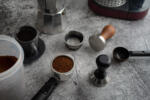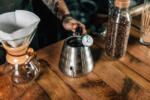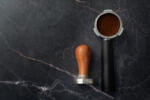Coffee contains various acids that enhance its flavors, and without any acidity, it wouldn’t taste the same. But if it’s too acidic, you’re not going to enjoy it as much, and it’s likely going to leave you with heartburn.
But you don’t have to drink coffee that’s too acidic, because here we’re showing you the best ways to make coffee that’s less acidic. These methods range from carefully picking the beans to adding salt to the brewed coffee.

So if you don’t like coffee that’s too acidic, or if you have health problems such as gastroesophageal reflux disease, there are various solutions that you can apply to make your brews less acidic.
Best Ways to Make Less Acid Coffee
Some coffee lovers have a digestive system that doesn’t handle the acids in coffee well, so any cup of coffee they drink can be rather unpleasant.
But coffee acidity doesn’t have to stop you from enjoying your favorite cup of java, as we explain below how to reduce the acidity of your coffee.
1. Use arabica beans
Arabica coffee beans are usually less acidic than robusta coffee beans. So simply switching from robusta to arabica will make your coffee much less acidic.
However, arabica coffee beans have considerable acidity, which could still be troublesome for some coffee lovers. The use of arabica coffee beans is a perfect starting point for making your coffee less acidic. However, it is important to remember that they will contain slightly lower caffeine content. Robusta beans have around 2.7 percent caffeine, while arabica would have around 1.5 percent caffeine.
So you’re going to have to decide if you’re comfortable with losing some caffeine boost to make your drink less acidic.
Arabica vs. Robusta Beans:
| Arabica Beans | Robusta Beans |
|---|---|
| Less acidic | More acidic |
| Smoother flavor | Stronger flavor |
| Lower caffeine | Higher caffeine |
2. Low altitude

Coffee grown at low altitudes tends to have less acidity than coffee grown at high altitudes in mountainous areas. Thus, although high-altitude coffee may be more flavorful, it will also come with a higher dose of acids.
Simply selecting low-altitude beans will greatly reduce the acidity of your coffee. Therefore, it is also important to know where the beans you use for your coffee are grown, as this will give you an idea of how acidic they will be. Most arabica coffee beans grow at high altitudes of up to 2,000 meters above sea level, while robusta beans grow just below 900 meters above sea level. However, robusta is also higher in caffeine.
This means that if you’re looking for less acidic beans, you can choose low-altitude arabica coffee because the plants will still thrive at a low altitude of just over 900 meters above sea level.
Costa Rican coffee, which grows a little over 1,300 feet above sea level, is a good example of low-altitude arabica coffee. It tends to be less acidic than coffee from other high-altitude growing regions in Ethiopia and Kenya.
3. Dark roast coffee

How you roast your coffee will also affect the acidity level, as the roasting process breaks down the acids. As such, it should be apparent that dark roasts will be less acidic than light roasts since the longer roasting time and higher heat will extract various compounds from the coffee, including the acids.
Light roasts are often referred to as bright, and the acidity of the coffee is emphasized. This roast gets its brightness from the acids in the coffee, such as malic acid, and it’s also one of the things that give it a citrus fruit taste.
While light and medium roasts are becoming increasingly popular as more and more coffee lovers choose to brew single-origin coffee beans, it’s best to avoid them if you dislike acidic coffee.
On the other hand, dark roasts will contain less acid because a significant portion of the coffee beans’ organic acids will be eliminated during roasting.
4. Cold brew method

The method you use to make your coffee also influences acidity since certain methods are known to emphasize acidity, while others, such as cold brewing, will inhibit it. So if you want to know how to neutralize the acid in your coffee, you can start by learning how to make a cold brew.
Cold brewing is a slow process that can take up to 24 hours, so if you want your coffee to be less acidic when using this method, you must plan and prepare it in advance.
Soaking your coffee in cold water during cold brewing will ensure that the organic acids are not over-extracted. When brewing with hot water, the acids are quickly extracted because the high temperature makes it easier for the coffee to release them. With cold water, it’s more difficult for coffee oils to produce acids.
By using cold water to brew your coffee, you’ll end up with coffee that’s up to 70% less acidic compared to hot water brewing. The only downside with cold brewing is that you can’t rely on it if you want a quick cup of coffee.
5. Acid reducer
One of the best ways to lessen the acid levels in your coffee is to induce a chemical reaction that neutralizes some of the acids using an acid reducer.
Acid reducers are readily available and low-cost, and if you’re a frequent coffee drinker, you should keep them on hand as they help ensure that your coffee cup is always up to your taste.
The acid reducer decreases the amount of acidity in your coffee and does so without affecting the taste. And if you have a good-quality one, it will reduce your coffee’s acidity by up to an amazing 90%, meaning that you won’t experience acid reflux.
The acid reducer works by binding the acids in your coffee together to make them less abundant, ensuring that your stomach does not get irritated after drinking the coffee. However, remember that they are not antacids but rather a preventive measure to minimize acidity before drinking coffee.
6. Using eggshell
Although it may sound a little odd, eggshells are a great way to reduce your coffee’s acidity, and besides being a simple process, they’re also one of the most effective methods.
Considering that eggshells are alkaline, they can neutralize acids, and organic acids in coffee are no exception. Even better, the use of eggshells also tends to make the coffee less bitter, which may be caused by over-dark roasting or over-steeping coffee grounds.
For this process, take one or a few eggshells, rinse them thoroughly in the sink, and then crush them well with your fingers before adding them to your coffee-making setup. Now, brew the coffee as you usually would, and it should be less acidic and less bitter.
But when using eggshells, you need to be careful not to let any of them end up in your coffee cup, which can be unpleasant.
7. A pinch of salt

A pinch of salt can also help to solve the issue of coffee acidity. And the great thing about salt is that you can either add it to the brewed coffee in your mug or during the brewing process.
Like eggshells, a pinch of salt can not only smooth out your acidic coffee, but it can also help reduce the bitterness of your coffee. Salt is alkaline, so it’s effective at neutralizing acidity.
However, you have to be careful about how much you’re using because you can easily end up with a salty taste in your coffee cup if you use too much of it.
This approach is the simplest and most convenient, as salt is commonly found in most homes. In addition to salt, you can also use baking soda, as it is also extremely alkaline and can neutralize acidity.
8. Make a hard water coffee
Filtered water typically produces the highest quality coffee, so it’s hard to imagine making your cup of java with hard water. However, if you have a major problem with acidity, hard water may be a better choice than soft water.
Hard water contains minerals such as calcium, which can quickly neutralize or overshadow the coffee’s acidity, making it less prevalent.
On the other hand, soft water is one of the key factors that make the coffee’s acidity more pronounced when used in brewing.
9. Using your paper filter
When using a coffee-making process that involves a filter, you can use a paper filter instead of a metal mesh to reduce your coffee’s acidity.
Paper filters will often produce a cleaner and lighter coffee cup, as they trap much of the coffee’s oils and fats. These oils and fats release acids into your coffee, so the paper filter can contribute to making your coffee less acidic by trapping them.
10. Add milk

If you have no objections to adding additives and lighteners to your coffee, you can also neutralize acidity by adding milk or even cream.
Calcium in these dairy products can help balance the pH of the coffee and reduce its acidity. This approach works best when using dark roasts because light roasts do not pair well with milk due to their high acidity.
Conclusion
Coffee that is too acidic is less flavorful and comes with unpleasant issues such as acid reflux. But acidity shouldn’t be the only reason to miss your dose of caffeine, as you can easily remedy it.
In this article, we’ve described some of the best ways to make coffee less acidic, and you can be sure that at least one of the above ten methods will work for you.
However, the best idea is to try various methods of reducing acidity before finding the one that gives you the best quality and taste of the coffee.
Disclaimer: This post contains affiliate links, which means I may receive a small commission, at no extra cost to you, if you make a purchase using these links. Remember to support us by purchasing through the Amazon/Walmart/Impact Radius links provided. Last update on 2024-04-26 / Affiliate links / Images from Amazon Product Advertising API
Disclosure: No compensation or free products were received in exchange for writing this review.

Editorial Staff
The editorial staff at Crazy Coffee Crave is a team of coffee enthusiasts & Baristas who enjoy the one thing we all think about as soon as we get up in the morning. Trusted by thousands of readers worldwide.





